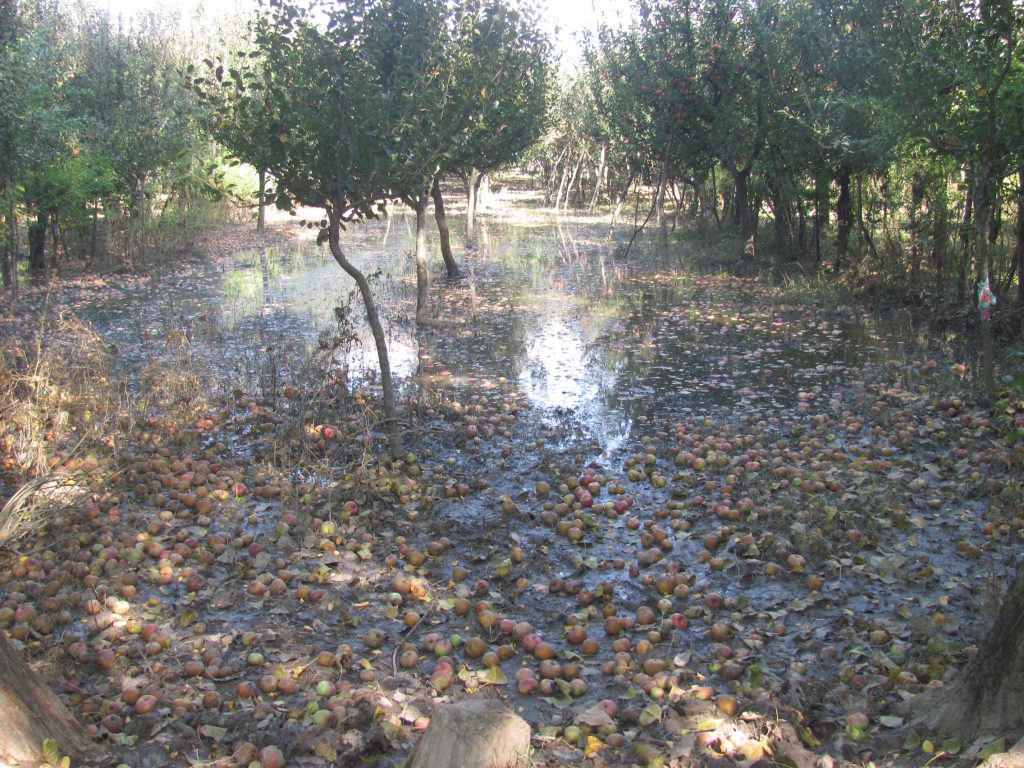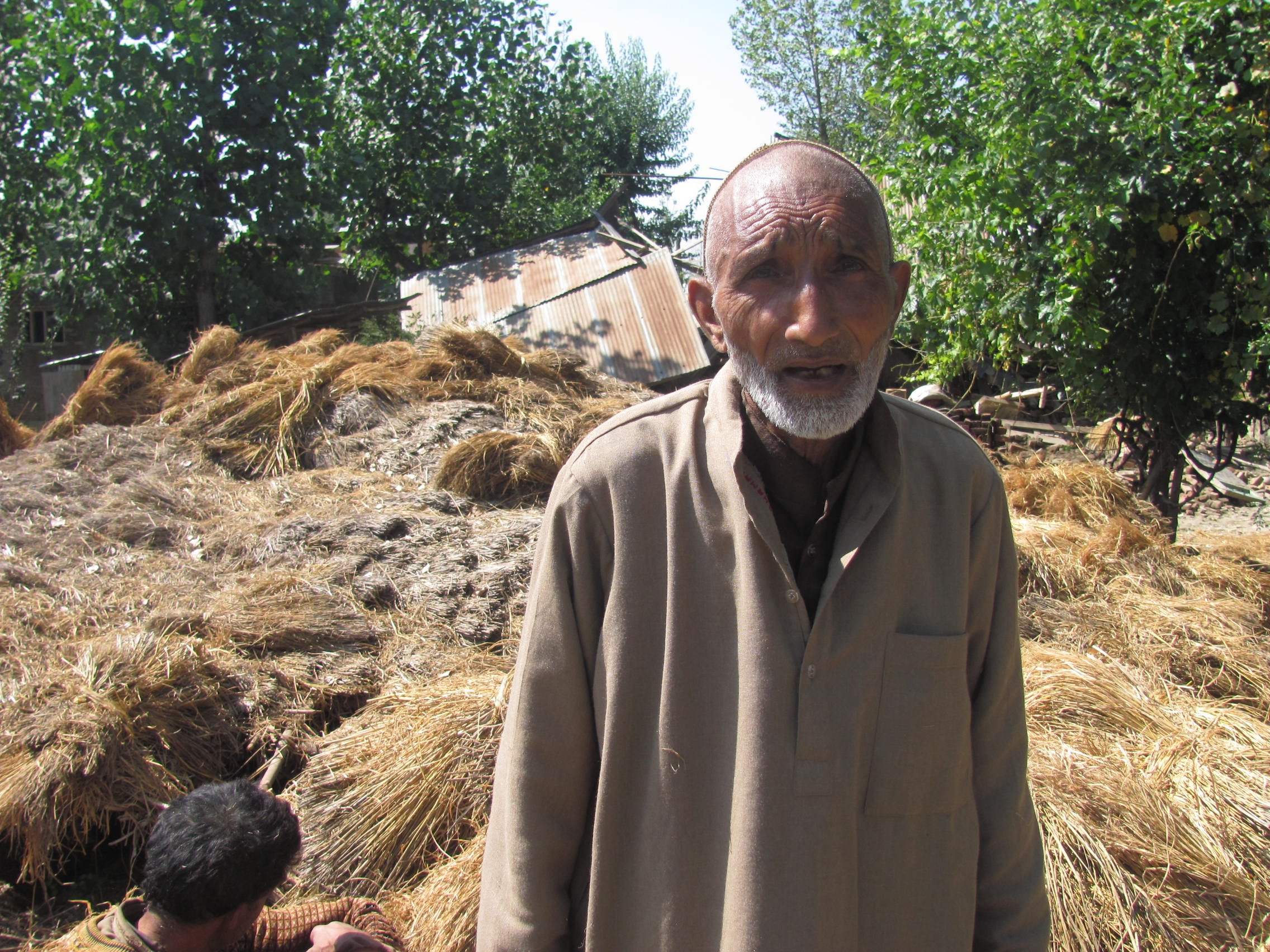It’s a long hard road to recovery for people in India’s Kashmir valley who are still scrambling to gather the remnants of their lives after the floods nearly two months ago. As temperatures dip by the day and a harsh winter looms ahead, more than 100,000 people are still homeless and farmers are amongst the worst hit.
While some have been forced to sell their cattle, others look helplessly at their sodden, muck-laden fields and damaged orchards – all spelling a tale of ruin and massive losses in the villages around Jammu and Kashmir state’s summer capital Srinagar and other parts of the Himalayan valley.
Official estimates have put the loss to agricultural products at Rs.30,750 million (about US$500 million) with standing crops destroyed in over 300,500 hectares. The estimates add that hundreds of acres of land have been washed away by floods and 3,811 hectares of land rendered uncultivable.
Most farmers in Kashmir have small land holdings averaging 0.67 hectares, states the annual report of Jammu and Kashmir’s directorate of economics and statistics. Nearly 75% of the state’s population lives in rural areas and is directly or indirectly dependent on agriculture, the department estimates.
Most of these farmers in southern and central Kashmir have borne the brunt of the September floods.
Wasted fields
Like Rajjab Lone, a farmer in the central district of Budgam, who has lost this year’s paddy crop and also faces the serious challenge of clearing the muck left behind by the floodwater on his one-and-a-half acres of land.
“What has remained with me out of this year’s paddy crop is the yield from a half acre plot which was in a different area,” Lone told thethirdpole.net. This year, he won’t be able to sell rice and fodder and will have to depend on the meagre wages of his two sons, who work as labourers.
“It (the crop) would fetch me at least Rs.80,000 (US$1,350) as well as feeding my six-member family and our cow,” added Lone. He hopes that the Omar Abdullah-led state government keeps its promise of providing free rations for six months to flood-affected people.
He also faces the huge task of removing the muck from his land to prepare it for a fresh crop. The government has not announced any specific plan for removing silt from agricultural land. Neither is there any specific programme for compensating those whose land has been washed away by the floods.
Many farmers have sold off their cattle fearing fodder shortage in the winter. Rifat Begam, a homemaker, managed to save her two cows during the flood but has now had to sell them both for a lower price. “Both the cows fetched me Rs.70,000 (US$1,166) though they were worth Rs.90,000 (US$1,500),” she said. “But I had no option as I could not feed them.”
The cows were her only source of livelihood. “Both the cows would yield 22 litres of milk a day. I would sell 21 and keep one litre, just about enough to feed and educate my only daughter.”
Mohammad Mohsin, an elderly farmer in Ganderpora-Narbal, about 17 kilometres from Srinagar, is desperately looking for fodder for his cattle. Sorting through putrefied grass damaged by the waters, he told thethirdpole.net, “I am doing it despite a warning from experts that it should not be given to the cattle. While I respect the experts’ opinions, I can’t leave my cattle hungry. The government should at least arrange some fodder so that we don’t lose them because of starvation.”
For Kazim Ali and his wife Rafiqa in the same village, the disaster has dealt a double blow. The couple and their four children have not just lost the crop, ready to be harvested on their one acre of agricultural land, but also a 10 metre squared carpet that Rafiqa and another woman had been weaving for two months.
“When the announcement came from the community address system that the floodwaters were entering our village, our first instinct was to save ourselves and get to safety. In the process, we forgot everything else, including the loom and the carpet,” she said.
Kashmir is famed for its carpets that are sought after across the world. Weaving carpets and embroidering shawls and other material fetches Rafiqa around Rs.200,000 (US$3,350) a year.
Apple growers
The valley is also known for its apples and apple growers say they are the worst sufferers with entire orchards destroyed.
“If I had lost my house, it would not have been such a big deal for me,” said Ghulam Ahmad whose orchard in the apple-rich belt of Gundjahangir in Bandipora district has been completely destoryed.
“I sell 1,700 boxes of apples on average every year. But this year, I have lost all of it,” he said, as he surveyed the picture of ruin with rotten apples floating on the still knee high waters.

At least seven other apple growers this reporter spoke to had similarly lost a major chunk of their yield.
Mohammad Rafiq of Sonawari, for instance, lost 500 boxes and considers himself lucky that he could sell the remaining 600 boxes.
All the farmers are worried that waterlogged fields could also impact next year’s produce. Experts have already warned that too much exposure to water would affect the health of the trees.
“Apple trees can hardly tolerate water for a few days. Water-logging impacts their roots, thereby impairing their nutrition uptake capability,” Akthar Hussain Malik, who teaches botany at Kashmir University, told thethirdpole.net.
The floodwater contaminated with fungal and bacterial spores can also cause diseases in these trees, he said.
The state agricultural ministry has announced it will provide seeds and fertilisers to farmers out of the state disaster relief fund (SDRF) and has requested Rs.201 million ($3.2 million) from the central government to fund this.
Government role
However, given the magnitude of the destruction, both the central and the state governments are being blamed for not doing enough.
On October, 23, Prime Minister Narendra Modi paid a much anticipated visit to the valley and generated hope that he would announce a comprehensive package. However, he announced a package of US$120 million for the reconstruction of houses and repairing hospital infrastructure. This was just a fraction of the assistance of Rs.44,000 crore (US$7,200 million) that Chief Minister Omar Abdullah had asked for.
While the opposition Congress party in New Delhi termed Modi’s package a “big letdown”, separatist leader Syed Ali Shah Geelani termed it a “cruel joke” and urged the Organisation of Islamic Countries to step in to help.
Harsh winter ahead
The lack of funds and the bone chilling winter ahead could lead to another disaster, not just for the farmers but for the nearly 100,000 people living in tented accommodations, camps and relatives’ homes.
Abdul Rahim, whose house in Srinagar was destroyed, is planning to arrange a prefab structure with the help of a private agency. This will cost him up to Rs.120,000 (US$2,033).
But what about those people who can’t arrange for such large sums?
Elections to the state assembly have been announced and will be held over multiple phases in November-December. Politicians of competing parties will once again come around asking for votes. The despairing people of Kashmir wait to see what is on offer for them – and whether the politicians will deliver on their promises.

